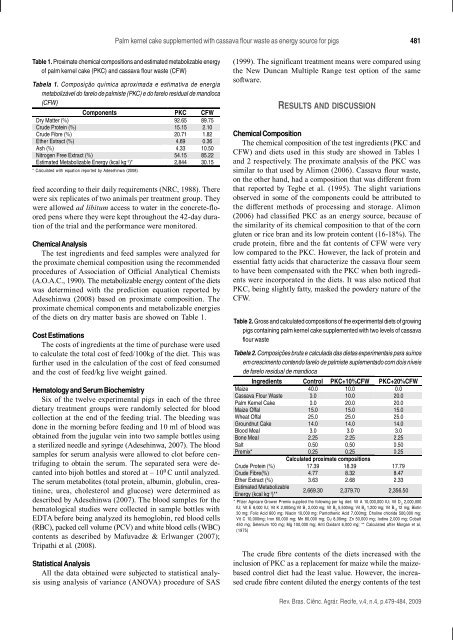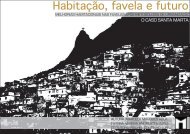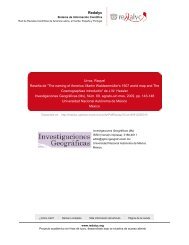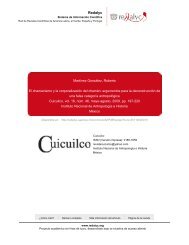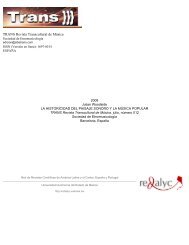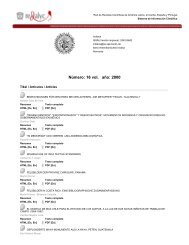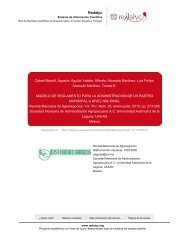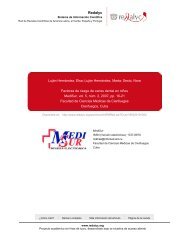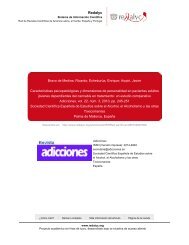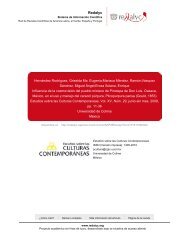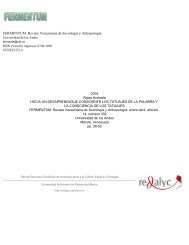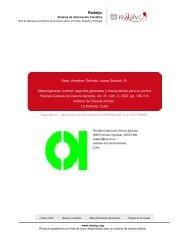Redalyc.Palm kernel cake supplemented with cassava flour waste ...
Redalyc.Palm kernel cake supplemented with cassava flour waste ...
Redalyc.Palm kernel cake supplemented with cassava flour waste ...
You also want an ePaper? Increase the reach of your titles
YUMPU automatically turns print PDFs into web optimized ePapers that Google loves.
<strong>Palm</strong> <strong>kernel</strong> <strong>cake</strong> <strong>supplemented</strong> <strong>with</strong> <strong>cassava</strong> <strong>flour</strong> <strong>waste</strong> as energy source for pigs<br />
Table 1. Proximate chemical compositions and estimated metabolizable energy<br />
of palm <strong>kernel</strong> <strong>cake</strong> (PKC) and <strong>cassava</strong> <strong>flour</strong> <strong>waste</strong> (CFW)<br />
Tabela 1. Composição química aproximada e estimativa de energia<br />
metabolizável do farelo de palmiste (PKC) e do farelo residual de mandioca<br />
(CFW)<br />
Components PKC CFW<br />
Dry Matter (%) 92.65 89.75<br />
Crude Protein (%) 15.15 2.10<br />
Crude Fibre (%) 20.71 1.82<br />
Ether Extract (%) 4.69 0.36<br />
Ash (%) 4.33 10.50<br />
Nitrogen Free Extract (%) 54.15 85.22<br />
Estimated Metabolizable Energy (kcal kg -1)* 2,844 30.15<br />
* Calculated <strong>with</strong> equation reported by Adesehinwa (2008)<br />
feed according to their daily requirements (NRC, 1988). There<br />
were six replicates of two animals per treatment group. They<br />
were allowed ad libitum access to water in the concrete-floored<br />
pens where they were kept throughout the 42-day duration<br />
of the trial and the performance were monitored.<br />
Chemical Analysis<br />
The test ingredients and feed samples were analyzed for<br />
the proximate chemical composition using the recommended<br />
procedures of Association of Official Analytical Chemists<br />
(A.O.A.C., 1990). The metabolizable energy content of the diets<br />
was determined <strong>with</strong> the prediction equation reported by<br />
Adesehinwa (2008) based on proximate composition. The<br />
proximate chemical components and metabolizable energies<br />
of the diets on dry matter basis are showed on Table 1.<br />
Cost Estimations<br />
The costs of ingredients at the time of purchase were used<br />
to calculate the total cost of feed/100kg of the diet. This was<br />
further used in the calculation of the cost of feed consumed<br />
and the cost of feed/kg live weight gained.<br />
Hematology and Serum Biochemistry<br />
Six of the twelve experimental pigs in each of the three<br />
dietary treatment groups were randomly selected for blood<br />
collection at the end of the feeding trial. The bleeding was<br />
done in the morning before feeding and 10 ml of blood was<br />
obtained from the jugular vein into two sample bottles using<br />
a sterilized needle and syringe (Adesehinwa, 2007). The blood<br />
samples for serum analysis were allowed to clot before centrifuging<br />
to obtain the serum. The separated sera were decanted<br />
into bijoh bottles and stored at – 10 0 C until analyzed.<br />
The serum metabolites (total protein, albumin, globulin, creatinine,<br />
urea, cholesterol and glucose) were determined as<br />
described by Adesehinwa (2007). The blood samples for the<br />
hematological studies were collected in sample bottles <strong>with</strong><br />
EDTA before being analyzed its hemoglobin, red blood cells<br />
(RBC), packed cell volume (PCV) and white blood cells (WBC)<br />
contents as described by Mafuvadze & Erlwanger (2007);<br />
Tripathi et al. (2008).<br />
Statistical Analysis<br />
All the data obtained were subjected to statistical analysis<br />
using analysis of variance (ANOVA) procedure of SAS<br />
481<br />
(1999). The significant treatment means were compared using<br />
the New Duncan Multiple Range test option of the same<br />
software.<br />
RESULTS AND DISCUSSION<br />
Chemical Composition<br />
The chemical composition of the test ingredients (PKC and<br />
CFW) and diets used in this study are showed in Tables 1<br />
and 2 respectively. The proximate analysis of the PKC was<br />
similar to that used by Alimon (2006). Cassava <strong>flour</strong> <strong>waste</strong>,<br />
on the other hand, had a composition that was different from<br />
that reported by Tegbe et al. (1995). The slight variations<br />
observed in some of the components could be attributed to<br />
the different methods of processing and storage. Alimon<br />
(2006) had classified PKC as an energy source, because of<br />
the similarity of its chemical composition to that of the corn<br />
gluten or rice bran and its low protein content (16-18%). The<br />
crude protein, fibre and the fat contents of CFW were very<br />
low compared to the PKC. However, the lack of protein and<br />
essential fatty acids that characterize the <strong>cassava</strong> <strong>flour</strong> seem<br />
to have been compensated <strong>with</strong> the PKC when both ingredients<br />
were incorporated in the diets. It was also noticed that<br />
PKC, being slightly fatty, masked the powdery nature of the<br />
CFW.<br />
Table 2. Gross and calculated compositions of the experimental diets of growing<br />
pigs containing palm <strong>kernel</strong> <strong>cake</strong> <strong>supplemented</strong> <strong>with</strong> two levels of <strong>cassava</strong><br />
<strong>flour</strong> <strong>waste</strong><br />
Tabela 2. Composições bruta e calculada das dietas experimentais para suínos<br />
em crescimento contendo farelo de palmiste suplementado com dois níveis<br />
de farelo residual de mandioca<br />
Ingredients Control PKC+10%CFW PKC+20%CFW<br />
Maize 40.0 10.0 0.0<br />
Cassava Flour Waste 0.0 10.0 20.0<br />
<strong>Palm</strong> Kernel Cake 0.0 20.0 20.0<br />
Maize Offal 15.0 15.0 15.0<br />
Wheat Offal 25.0 25.0 25.0<br />
Groundnut Cake 14.0 14.0 14.0<br />
Blood Meal 3.0 3.0 3.0<br />
Bone Meal 2.25 2.25 2.25<br />
Salt 0.50 0.50 0.50<br />
Premix* 0.25 0.25 0.25<br />
Calculated proximate compositions<br />
Crude Protein (%) 17.39 18.39 17.79<br />
Crude Fibre(%) 4.77 8.32 8.47<br />
Ether Extract (%) 3.63 2.68 2.33<br />
Estimated Metabolizable<br />
Energy (kcal kg-1 )**<br />
2,669.30 2,379.70 2,356.50<br />
* Pfizer Agricare Grower Premix supplied the following per kg diet: Vit A 10,000,000 IU; Vit D 3 2,000,000<br />
IU; Vit E 8,000 IU; Vit K 2,000mg;Vit B 1 2,000 mg; Vit B 2 5,500mg; Vit B 6 1,200 mg; Vit B 12 12 mg; Biotin<br />
30 mg; Folic Acid 600 mg; Niacin 10,000 mg; Pantothenic Acid 7,000mg; Choline chloride 500,000 mg;<br />
Vit C 10,000mg; Iron 60,000 mg; Mn 80,000 mg; Cu 8,00mg; Zn 50,000 mg; Iodine 2,000 mg; Cobalt<br />
450 mg; Selenium 100 mg; Mg 100,000 mg; Anti Oxidant 6,000 mg; ** Calculated after Morgan et al.<br />
(1975)<br />
The crude fibre contents of the diets increased <strong>with</strong> the<br />
inclusion of PKC as a replacement for maize while the maizebased<br />
control diet had the least value. However, the increased<br />
crude fibre content diluted the energy contents of the test<br />
Rev. Bras. Ciênc. Agrár. Recife, v.4, n.4, p.479-484, 2009


